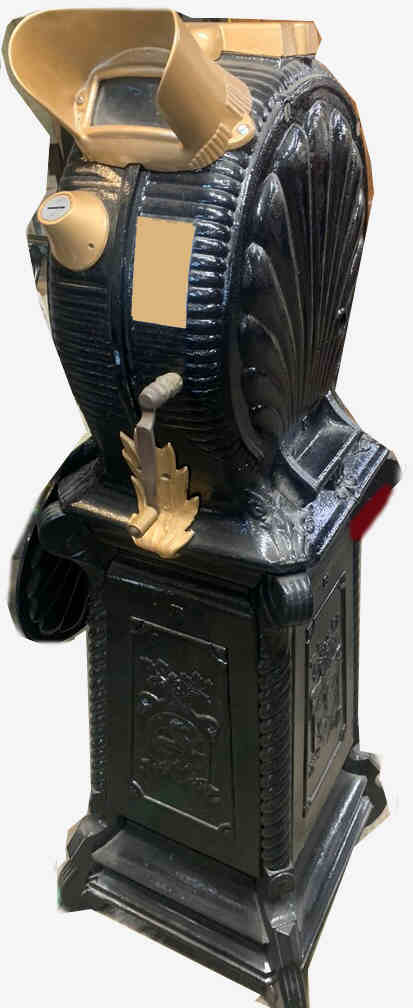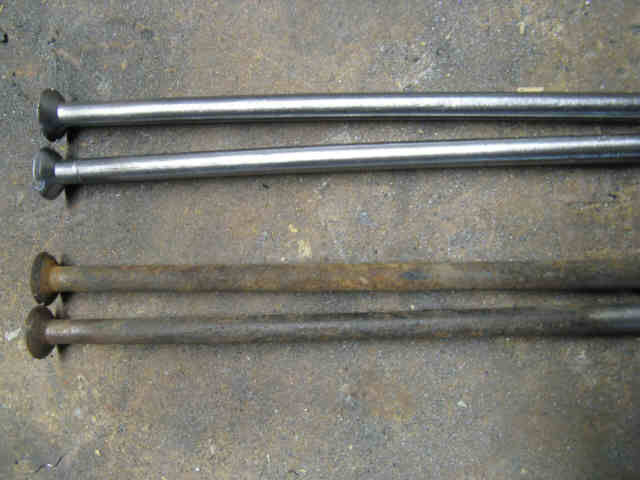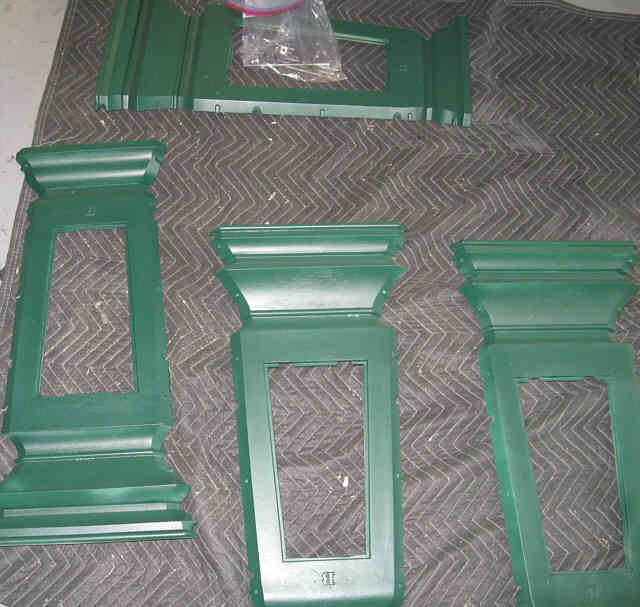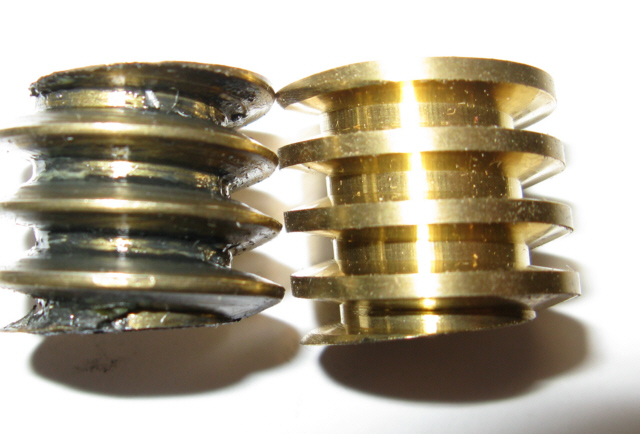
Here it is as received, you'll notice that it has a "rigged" handle
Not seen in the photo is damage at the base on one side, damage to one bottom door, a missing door latch and
finally damage to the clamshell door.
All of these things will be addressed.
Also not shown in the above photo is the cast iron marquee frame. The marquee will be finished
to match the refinished mutoscope.
It is currently not wired for electric light use, this too will be corrected.
A Brief Mutoscope
History
Much like how a flip book works, it creates a moving image by cranking a handle on the machine front.
The original cards were contact printed from 70 mm film. The first Mutoscope was produced in 1895 and soon replaced earlier machine types. since the cards were larger and they did not deteriorate with use.
By I897,
the Mutoscope was very popular in arcades. These early machines and
reels are
sought after as antiques of the early days of Cinema. The original
Mutoscope patent was issued in I895 to Herman Casler of Oneonta, New
York, and
the prototype was built in a machine shop in Syracuse, where he worked.
Sometime later,W.K.L.Dickson,an associate of Edison,stated that the
original
idea was his. The two men and two other partners formed a syndicate
that later
became the American Mutoscope and Biograph Company. Although the
card-flipping
principle was not new. The circular card reel was an innovation. The
viewing
time of one rotation (8OO to 85O cards) was about one minute, the same
as that
of the average thirty-foot film produced by then existing cameras.
The
Biograph Company developed its own camera, the "Mutograph' and later a
projector, the "Biograph." With this projector, the commercial
motion-picture theater was born, and the Mutoscope lost popularity,
though
it continued its life in the arcades. Between 1897 and I907, which
is considered the
classic
age of the Mutoscope, over l,000 titles and 100,000 reels were printed
and
distributed. How many are still out there is unknown. The early actors
and
actresses appeared generally without credit. Some reels were made in
series
such as "Happy Hooligan,"
"Rip Van Winkle" and "Foxy Grandpa," others were short
plays and comedies, and still others were scenic views like
"Niagara
Falls” and "Atlantic City Boardwalk".
After
projected films began to be produced, newsreels, sporting events and
Hollywood
films were cut to fit the Mutoscope's one minute viewing time. Chaplin,
Mabel
Normand, Tom Mix and other name actors appeared, including animated
features.
However the Mutoscope is above all famous for the "Girlies" dance and
strip-tease subjects (peep shows).
A friend of mine who helped in obtaining this mutoscope, had a trip scheduled to come down to Florida and was kind enough to bring it along and drop it off.
It was partially disassembled for it's journey.
These are small enough to fit into most cars, if disassembled would fit into pretty much any car, maybe not a "smart car"
The transformation begins
The head unit was disassembled.
The mechanism removed.
The viewer was disassembled and top light window along with the ID plate were removed.
The handle on the mechanism shaft was cut off to remove it , since no roll pin etc could be located
Here the mechanism after removal and partial disassembly.

Evaluation , cleaning and whatever needed repairs are needed will be done.
The gear that the "J" hook rides on has been cleaned, along with the worm gear that drives it.
New grease will be applied later.
The gear seen at the top couples to a bevel gear and is driven by the cranking of the handle when a coin has started the process.
Each tooth of that gear will be individually cleaned removing 100 years of dried out impacted grease in those teeth.
Closer examination later of this gear and it's worm gear revealed wear. There is considerable play of the worm gear on it's shaft as well as some teeth on the large gear it drives. During operation when the reel is turning it can reach a point where it will jump because of this wear
These gears will have to be replaced for perfect operation.
That large reel driving gear is very interesting as it has 2 tracks that the "J" arm follows , first a higher track then it drops to a lower track that allows the rotation of the reel to be stopped when it reaches the reel end and resets mechanism for the next coin.
At the top middle of the photo is a bracket that will hold the porcelain lamp socket and light bulb. once it's electrified.
This "B" model could operate without it with bright room light or marquee frame light on, because it has a window at the top of the case.
This was a really interesting find.
This was used as a washer

Thats an Indian Head Penny 1897
All the hardware was cleaned, all paint and rust removed. Below is an example showing two of the long case bolts rust removed along with 2 in as found condition.

Here is a transition photo

Here after the paint was removed, and the parts primed, along with serious issues addressed they were painted this dark green satin color.

Here some other parts after painting

The gold looks great
Here reassemble of the cabinet base has begun

One bottom door was test fit (though not finished yet) Detailing has begun here, The first coat of gold applied to the test panel and "B"
There is dust on the green base panels that will clean off.


Here most of the cabinet has been detailed. All the gold on the cabinet, with exception of the legs,viewfinder, coin casting and leaves was hand painted.
A number of coats of gold paint was applied to the detail areas to get the result seen here.
Shown in the photo of the mechanism above is the lamp socket bracket minus the lamp socket.
The mutoscope uses an early porcelain socket made by Bryant. It is wider than other similar sockets and is needed to span the mounting hole distances.

Here installed and tested. It will turn on when the movie starts and goes off when it ends.

Here below a marquee light was added, along with a new sign which was created to show the correct title of the reel received with the machine.
Now waiting for parts to finalize the mechanism restoration and install it along with the viewfinder assembly

Almost done
Ok, it turns out, I had to pause before re-assembling the mutoscope.
I was not happy with the way the mechanism worked. It would sometimes slip attempting to play a movie completely through.
I found the clutch slipped more than it should (not the cause)
It turned out that the biggest problem and wear was on that brass worm gear.
That gear effectively transfers all the cranking energy to rotate the movie.
This is what caused the movie to "Slip" or jump.
So, in the end 3 of the 4 gears were replaced.
And it's DONE
Thanks Joe K. ! for your help

Below: Some notes on getting the mechanism to operate correctly

Below is an exploded view of a model "S" mutoscope (different than above)
This is a cleaned up version of what is posted on Tom Reverand's website at http://www.oldtimemovies.org/ site
Posted here just as an interesting piece of information
A lot of the parts are the same as the Clamshell machine

